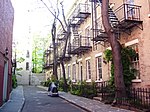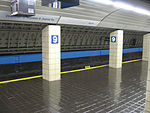Jefferson Market Library

The Jefferson Market Branch of the New York Public Library, once known as the Jefferson Market Courthouse, is a National Historic Landmark located at 425 Avenue of the Americas (Sixth Avenue), on the southwest corner of West 10th Street, in Greenwich Village, Manhattan, New York City, on a triangular plot formed by Greenwich Avenue and West 10th Street. It was originally built as the Third Judicial District Courthouse from 1874 to 1877, and was designed by architect Frederick Clarke Withers of the firm of Vaux and Withers. Though faced with demolition in 1958, public outcry led to its reuse as a branch of the New York Public Library. The building is now part of the New York City Landmark Preservation Commission's Greenwich Village Historic District, created in 1969. In addition, the building was placed on the National Register of Historic Places in 1972 and made a National Historic Landmark in 1977. The AIA Guide to New York City calls the building "A mock Neuschwansteinian assemblage ... of leaded glass, steeply sloping roofs, gables, pinnacles, Venetian Gothic embellishments, and an intricate tower and clock; one of the City's most remarkable buildings."
Excerpt from the Wikipedia article Jefferson Market Library (License: CC BY-SA 3.0, Authors, Images).Jefferson Market Library
6th Avenue, New York Manhattan
Geographical coordinates (GPS) Address Phone number Website External links Nearby Places Show on map
Geographical coordinates (GPS)
| Latitude | Longitude |
|---|---|
| N 40.734722222222 ° | E -73.999166666667 ° |
Address
Jefferson Market Library
6th Avenue 425
10011 New York, Manhattan
New York, United States
Open on Google Maps





